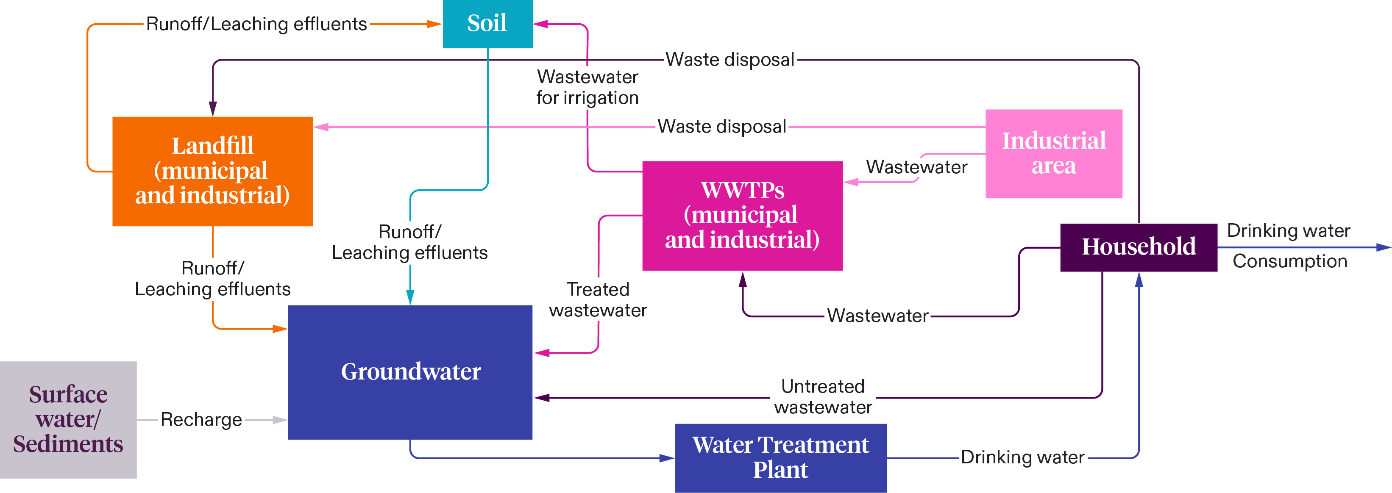Article
What do phthalates and the Norfolk Southern train derailment have in common?
With the news full of the toxic fallout linked to the Norfolk Southern train derailment in East Palestine, Ohio, and the release of vinyl chloride, this article considers the potential impacts of phthalates and considers its use and industrial sources of contamination, effects on human health and the environment, routes of exposure, regulation, and insurance implications.
What is it?
"Phthalates (often called plasticizers, colorless, odorless, oily liquids) are a family of low-volatility benzene derivatives that are formed by esterification of phthalic acid. Phthalates are added to increase the flexibility, durability, and softness of commercial plastics, which are incorporated into a wide variety of consumer goods. Ingested phthalates may exhibit estrogenic or antiandrogenic effects or they may function as endocrine disruptors. Exposure to phthalates may increase the risk of certain cancers.” (National Library of Medicine)
The Nature of the Problem
The demand for phthalates is continuously increasing because of low manufacturing costs and a lack of alternatives, leading to the piling of phthalate compounds into the environment. People are constantly exposed to plastics (e.g., contaminated soil, groundwater, surface water, and sediments), atmospheric fallout, and urban dust containing microplastics, contaminated food, packaging leachate, personal care products, and synthetic clothing. Long-term plastic exposure would inevitably lead to contact with many harmful substances because of leaching. The most common chemicals of concern include phthalates, bisphenol A (BPA), and polychlorinated biphenyls (PCBs). These substances have been identified as endocrine-disrupting chemicals, which interfere with normal hormonal actions. Phthalates are a series of chemical substances, which are mainly used as plasticizers added to polyvinyl chloride (PVC) plastics for softening effects. Health concerns regarding the detrimental impacts of phthalates on the development and reproductive system have been raised in recent decades. Compared to adults, children are much more vulnerable and sensitive to phthalates exposure, especially during early growth [1].
Health impacts include:
| Category | Health Concerns |
| Endocrine systems | Weight (overweight and obesity) and height Type II diabetes and insulin resistance Thyroid function and increased risk of thyroid cancer Higher systolic blood pressure Anogenital distance Precocious puberty Males: genital development, semen quality Females: pregnancy outcome (pregnancy loss and preterm birth, low birth weight), reproductive hormones (including luteinizing hormone, sex hormone-binding globulin, earlier menopause) |
| Other | Respiratory system: allergy and asthma Nervous system: delayed neurodevelopment, social impairment |
References: [1]
Does this sound familiar? If you are reminded of per-and polyfluoroalkyl substances (PFAS), you would be correct. We have yet to chart a holistic public policy and regulatory course for PFAS, yet here we are, confronted again with another seemingly ubiquitous global concern.
Uses
Now that we know what it is, where is it used? The industrial uses of these chemicals are diverse. Often referred to as the “everywhere chemical [2],” phthalates can be found in the following industries and products including:
- automotive parts/interiors
- tools
- plastics
- vinyl seat covers
- interior trim/PVC skin
- solvents
- windows
- personal care products
- cosmetics
- body side moulding
- window shades
- PVC products
- wire and cabling
- insecticides
- medical devices/products
- synthetic lubricants/oils
- paints and sealants
- window shades
- carpet and tile
- artificial textiles
- food packaging
- baby products
- building and construction
- home and bath products
- adhesives
- printing inks
- electrical wiring coating
- pharmaceuticals
- flooring
- pool liners
- roofing
- wall coverings
- chemical manufacturing
References: [1], [2], [3], [4], [5]
So, what is the problem?
“The U.S. Environmental Protection Agency (EPA) is concerned about phthalates because of their toxicity and the evidence of pervasive human and environmental exposure to these chemicals. Phthalates are used in many industrial and consumer products (as noted above), many of which pose potentially high exposure. Phthalates have been detected in food and have been measured in humans.”
Routes of Exposure to the Environment
Phthalates are released to the environment from multiple sources including:
- industrial releases;
- the disposal of manufacturing, processing, and industrial wastes;
- municipal solid waste;
- land application of sewage sludge; and
- leaching, migration, and oxidation from products containing phthalates [6, 7].
Numerous routes of exposure exist as depicted in the figure below [8].

Proposed Actions
In February 2023, the EPA introduced Draft Proposed Principles of Cumulative Risk Assessment (CRA) under the Toxic Substances Control Act (TSCA). "EPA recognizes that for some chemical substances undergoing risk evaluation, the best available science may indicate that the development of a CRA is appropriate to ensure that any risks to human health and the environment are adequately characterized.” Meaning, people and the environment do not face risks from a single chemical alone; rather, the risks being faced are a result of exposure to multiple chemicals at once. With respect to phthalates, “EPA believes that the best approach to evaluate risk to human health may be to look at the combined risk to health from multiple chemicals with similar effects simultaneously [6], [9]." Initially, the EPA will focus on five phthalates, which are designated as high-priority substances under TSCA, including:
- diethylhexyl phthalate, or DEHP;
- butyl benzyl phthalate, or BBP;
- dibutyl phthalate, or DBP;
- diisobutyl phthalate, or DIBP;
- dicyclohexyl phthalate, or DCHP; and
Two additional phthalates subject to manufacturer-requested risk evaluation, including:
- diisononyl phthalate, or DIN; and
- diisodecyl phthalate, or DIDP [6], [9].
Under TSCA, the EPA has authority to require reporting, record-keeping and testing requirements, and restrictions relating to chemical substances and/or mixtures. Currently, there is somewhat limited guidance and regulation around phthalate(s), except for Maximum Contaminant Levels (MCLs) in drinking water as an example; however, it is likely that increased scrutiny and regulation will occur over time.
And, that time may be now. Those keeping with current events are aware of the release of vinyl chloride in East Palestine, Ohio linked to the Norfolk Southern train derailment:
‘Vinyl chloride is particularly dangerous and increasingly common and used primarily to make PVC (made possible due to phthalates), the manufacturing of which is expanding into many parts of the country including OH, PA, and WV. There are calls to discontinue the use of vinyl chloride and PVC plastics, including suggested bans of PVC in certain products. In fact, there are calls to label discarded PVC as hazardous waste. Does any of this sound familiar (e.g., PFAS)? Many of the vinyl chloride and PVC manufacturers are located in Louisiana’s infamous “Cancer Alley.” People in one town in the area, most of whom are Black, have about 50 times the risk of developing cancer as the average American [10].’
How can I avoid phthalates?
‘Human exposure to phthalates occurs primarily through the consumer product chain via ingestion, inhalation, skin absorption, and intravenous injection, to name but a few. It would be impossible to avoid all exposure to phthalates; however, the avoidance of plastics would be an obvious first step.
A simple way to recognize plastic toys, clothing, bottles, food and beverage storage containers, and/or food wrap that may contain phthalate(s) is to look for the number 3 inside the universal recycling symbol usually heat-moulded into the plastic on the bottom of the product. Avoid products with the number 3 within the arrows and the letters “V” or “PVC” below the arrows, as depicted in the figure below [5].’

‘Instead, choose products with the numbers 1,2, 4, and 5 within the arrows. Many companies use phthalate-free substances such as polypropylene (PP), recycling code 5, to manufacture plastic products [5].’

Insurance implications
The implications and responsibilities are broadly evident for those of us that insure against contaminants and environmental pollution with potentially far-reaching and detrimental effects and consequences. And, as our understanding of the problems and issues linked to phthalates continues to grow, increased regulation will likely be inevitable. One can only guess as to the magnitude of clean-up liability and potential damages associated with bodily injury and property damage arising out of phthalates.
In summary, whether it be an upstream primary chemical manufacturer; intermediate product manufacturer; treatment, storage or disposal facility (TSDF); product end-user; water/wastewater treatment plant owner, operator or municipality; or the general public, phthalates represent an emerging risk that requires the attention of all that are involved in the fields of risk management and insurance. No single insurance policy applies. A fabric of interwoven coverage extending to products, operations, and site-specific issues is needed. Environmental insurance will always be in demand and will continue to evolve. It’s why we’re here.
-

James Wilkins
Underwriter - Environmental
The information set forth in this document is intended as general risk management information. It is made available with the understanding that Beazley does not render legal services or advice. It should not be construed or relied upon as legal advice and is not intended as a substitute for consultation with counsel. Beazley has not examined and/ or had access to any particular circumstances, needs, contracts and/or operations of any party having access to this document. There may be specific issues under applicable law, or related to the particular circumstances of your contracts or operations, for which you may wish the assistance of counsel. Although reasonable care has been taken in preparing the information set forth in this document, Beazley accepts no responsibility for any errors it may contain or for any losses allegedly attributable to this information.
References
- National Center for Biotechnology Information, National Library of Medicine (May 2021)
- College of Environment, Zhejiang University of Technology, Hangzhou 310032, China
- School of Public Health and Preventive Medicine, Monash University, Melbourne 3000, Australia
- American Chemistry Council
- Centers for Disease Control and Prevention
- U.S. Food and Drug Administration
- National Institute of Environmental Health Sciences, Zero Breast Cancer
- U.S. Environmental Protection Agency
- Environmental Contamination with Phthalates and its Impact on Living Organisms, De Gruyter, Paulina A. Przybylinska and Miroslaw Wyszkowski, DOI: 10.1515/eces-2016-0024, ECOL CHEM ENG S. 2016;23(2):347-356
- Groundwater contamination pathways of phthalates and bisphenol A: origin, characteristics, transport, and fate – A review, Science Direct, Volume 170, December 2022, Jaime Dueñas-Moreno, Abrahan Mora, Pabel Cervantes-Avilés, and Jürgen Mahlknecht
- EPA Floats Cumulative Risks Principles for TSCA Reviews, LAW360, Juan Carlos Rodriguez, February 24, 2023
- This Deadly Chemical Should Be Banned, The New York Times, Rebecca Fuoco, David Rosner, and Gerald Markowitz, February 19, 2023
